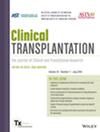Transplantation is a critical treatment for end-stage heart disease and improves length and quality of life. We investigated predictors of functional status improvement following transplant and the association between functional status trajectory and survival.
We conducted a retrospective cohort study using Scientific Registry of Transplant Recipients data on 34 009 US adults who underwent heart transplant 2006–2021. Functional status was measured using the Karnofsky Performance Scale (KPS; 0%–100%). Linear regression with stepwise selection was used to identify predictors of KPS trajectories. Kaplan–Meier curves and adjusted Cox proportional hazard models were used to compare survival.
Mean KPS was low at listing (47.9%) and transplant (45.6%) and increased to 85.7% and 89.2% at 1- and 5-years posttransplant. Independent predictors of KPS trajectory in the first year included hypertension, diabetes, BMI, prior tobacco, previous malignancy, age, sex, education level, insurance type, etiology of heart disease, prior cardiac surgery, “1A” waitlist priority, and hospitalization status. KPS trajectory during the waitlist period and the first year posttransplant predicted survival, independent of baseline KPS. Decrease in KPS > −30% and −30% to < 0% in the first year were associated with 5.74 (3.45–9.56) and 2.09 (1.69–2.59) times higher mortality than stable KPS after adjusting for baseline KPS and other factors. Poor KPS trajectory in the waitlist period was similarly associated with higher mortality.
Functional status improvement is an important outcome following heart transplantation, and KPS trajectory predicts survival. Most patients achieve high KPS, but clinical and social interventions may optimize KPS trajectory for high-risk patients.


